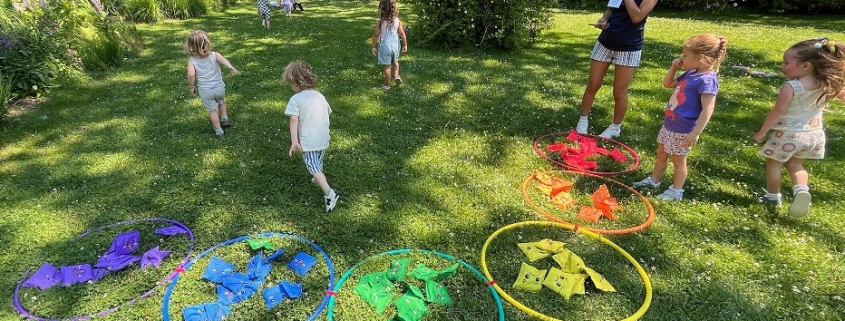10 Fun Campfire Games & Activities For Your Whole Crew
Summer nights around the campfire are magical for kids and adults alike. The flickering flames and starry skies create the perfect setting for storytelling, laughter, and games.
Whether you’re at a campsite or in your backyard, these campfire activities will ensure everyone has a night to remember after enjoying those delightful s’mores.
1. Fortunately, Unfortunately: A Storytelling Game
“Fortunately, Unfortunately” is a fun, creative storytelling game that encourages kids to use their imaginations and think on their feet. It’s perfect for kids aged 6 and up but can be adapted for younger children with a little help.
- Recommended Players: 3+
- How to Play: Gather the kids around the campfire and start a story with a sentence beginning with “Fortunately…” The next player adds to the story with a sentence starting with “Unfortunately…” Players take turns alternating between fortunate and unfortunate events, creating a hilarious and unpredictable tale. Let your crew know the story will end after everyone has had a chance to come up with three sentences.
- Example:
- Player 1: “Fortunately, the campers found a treasure map.”
- Player 2: “Unfortunately, it was guarded by a grumpy bear.”
- Player 3: “Fortunately, the bear loved marshmallows, and they had plenty to share.”
- Story Starter Ideas:
- Once there was a monkey who wanted to be a movie star.
- One day, I got a new puppy.
- One day, a woman discovered a dinosaur bone in her backyard.
- I was throwing a birthday party for my grandma.
- Last week I found a diamond ring on the pavement.
- Two explorers were travelling along the Amazon River.
- The cat jumped through the open window.
- I went for a walk in the countryside.
- A girl walked into the store to buy a new pair of shoes.
- I decided to learn to play the tuba.
This game is great for encouraging creativity, positivity, and cooperation, as kids build off each other’s ideas to create a unique story that (hopefully) has a happy ending.
2. Glow-in-the-Dark Hide and Seek
Turn an ordinary game of hide and seek into an exciting nighttime adventure with glow sticks or flashlights. This game is suitable for kids of all ages and adds an element of mystery and fun to the classic game.
- Recommended Players: 4+
- How to Play: Before starting the game, give each player a glow stick or a flashlight. Choose one player to be the seeker, while the others hide within a designated area. The seeker counts to a set number, then searches for the hidden players using their glow stick or flashlight to light the way.
- “Capture the Glow” Variation (6+ players): Divide players into two teams of three, giving each a designated base where their color glowstick is hiding. Each team must try to capture the other team’s object and bring it back to the base without getting tagged. Once tagged, the players must go to a designated glow jail. Teammates can then try to free them from the jail before getting tagged. This variation encourages teamwork and strategic planning, as players must decide whether to defend their base, free their friends, or go after the opposing team’s glow.
- Safety Tips: Ensure the play area is safe and free of obstacles. Set clear boundaries to keep everyone safe and within sight. You may also consider using flashlights.
Glow-in-the-dark hide and seek is a great way to encourage kids to explore and interact with their environment while also developing their listening and problem-solving skills.
3. Campfire Charades
Campfire charades is a classic game that never gets old. It’s perfect for all ages and can be easily adapted to suit the interests and abilities of the group.
- Recommended Players: 4+
- How to Play: Divide the players into two teams. One player from the first team selects a card with a word or phrase written on it (like “roasting marshmallows” or “catching fireflies”) and acts it out without speaking. Their teammates have a set amount of time to guess the word or phrase. If they succeed, they earn a point. Then it’s the other team’s turn.
- Ideas for Charades:
- Animals (e.g., bear, owl, squirrel)
- Campfire activities (e.g., fishing, hiking, canoeing)
- Emotions (e.g., happy, scared, excited)
Charades helps kids improve their nonverbal communication and teamwork skills while having a blast with their friends and family.
4. Nature Scavenger Hunt
A nature scavenger hunt is an educational and entertaining way to explore the natural surroundings of your campsite or backyard. It encourages kids to observe and appreciate the environment while having fun.
- Recommended Players: 4+
- How to Play: Create a list of natural items for the kids to find, such as pinecones, interesting rocks, or specific leaves. Give each child a bag to collect their treasures. You can also include tasks like spotting a certain type of bird or finding a feather.
- Bonus Activity: Encourage the kids to share their findings and discuss the importance of each item in the ecosystem.
This activity is perfect for kids who love exploring the outdoors and discovering new things. It also promotes environmental awareness and appreciation for nature.
5. Where in the World Are We?
- Recommended Players: 3+
- How to Play: This game is ideal for reminiscing about past vacations and trips. One family member thinks of a specific past destination and gives three distinct clues about it. The others try to guess the location based on the clues provided. The first person to guess correctly gets to be the next clue-giver.
Perfect for families, this easy game encourages storytelling and helps create bonds by sharing memories. And it’s a great way to spark conversations about past adventures.
6. What’s Yours Like?
- Recommended Players: 4+
- How to Play: Choose one player to be the guesser, who steps away from the group temporarily. The remaining players secretly decide on a common object or attribute (e.g., feet, hair). The guesser returns and asks, “What’s yours like?” Each player gives a one-word or short description of their item. The guesser tries to deduce the secret word based on the clues provided. If they don’t guess correctly after one round, they can request additional descriptions.
Filled with laughter and creative thinking, players love trying to come up with clever descriptions that are accurate but not too revealing.
7. Excuses
- Recommended Players: 4+ (Two main players, others as an audience)
- How to Play: Two players take the roles of a boss and a latecomer, while the rest of the group decides on a humorous reason why the latecomer is late. The boss knows the excuse and gives subtle hints, while the latecomer tries to guess it.
- Excuse Ideas:
- They accidentally entered a time machine and went back to the dinosaur era.
- Their pet dragon flew away with their shoes.
- They were stuck in a treehouse because a monkey stole their ladder.
This game develops improvisational skills and humor, encouraging players to think on their feet while engaging the group in the unfolding story.
8. Wink Assassin
- Recommended Players: 6+
- How to Play: Appoint a Godfather who secretly chooses the Assassin by tapping a player’s back while everyone’s eyes are closed. Then the Godfather shakes hands with a chosen Detective. The Assassin discreetly “kills” other players by winking at them. Players who are winked at count to five silently and then dramatically “die” by making a sound, falling off their chair, or giving a farewell speech. The Detective’s goal is to identify the Assassin before everyone is “killed.”
This game combines elements of mystery and drama, allowing players to engage in fun role-playing. It’s perfect for encouraging creativity and dramatic expression.
9. Sasquatch Evidence
- Recommended Players: 4-10 participants, ideally split into different roles.
- How to Play: Each player will be tasked with finding something around the campsite that they must present, along with an explanation of how this object provides “clear and compelling evidence” that a Sasquatch is afoot in the area. The judge will select a “mystery item” for all participants to guess its relevance to the sasquatch lore, and then choose winners for the following categories: Most Convincing Physical Evidence, Most Creative Backstory, Best Role Performance, and Best Mystery Item Guess.
- Optional Role Assignments: For older kids, assign roles and provide a brief description of the type of evidence they should find: Naturalist (natural objects disturbed by sasquatch), Botanist (plant-life eaten or disturbed by sasquatch), Cryptozoologist (mythical or fantastical evidence), and Detective (clues from the scene – maps, evidence notes, sketches) to each participant. One person will also play the role of Judge.
- Variations: Once you’ve found a sasquatch at camp, there’s no limit to what you might find next — alien, unicorn, fairy, troll, dragon, wizard, dinosaur, el chupacabra, monster, ghost, zombie, werewolf, vampire, supervillain!
This playful and inventive game combines humor and creativity, enhancing presentation and communication skills through ideation, storytelling, and performance. It fosters teamwork as participants collaboratively weave each item into an expanding and entertaining lore.
Note: This game has been uniquely crafted for Shine NYC readers, offering a fresh and innovative experience that even the most seasoned campfire enthusiasts will find completely novel and exciting!
10. Campfire Sing-Along
No campfire experience is complete without a sing-along. Singing around the fire is a timeless tradition that brings everyone together and creates lasting memories.
- Recommended Players: 2+
- How to Play: Gather around the campfire and sing favorite campfire songs. Encourage the kids to choose songs and lead the group. Provide simple instruments like tambourines or maracas to add rhythm to the music.
- Song Ideas:
- “The Lion Sleeps Tonight”
- “Twinkle, Twinkle, Little Star”
- “The Ants Go Marching”
- “Five Green and Speckled Frogs”
- “The Hokey Pokey”
- “We’re Going On A Bear Hunt”
- “If You’re Happy and You Know It”
- “Five Little Monkeys Jumping On The Bed”
- “This Old Man”
- “Creepy Crawly Crawfish”
A campfire sing-along is a wonderful way to wrap up the night, leaving everyone with a sense of togetherness and joy.
Campfires are more than just “cowboy TV.” They’re a chance to engage in creative and interactive games that provide free entertainment, while helping kids develop valuable skills such as creativity, teamwork, and communication. Whether you’re hunting for sasquatch, solving a murder mystery, or simply singing songs, these activities will make your campfire nights the stuff memories are made of.



